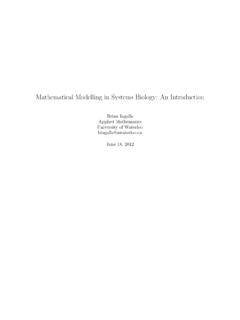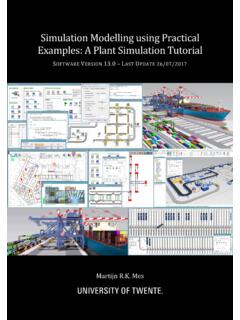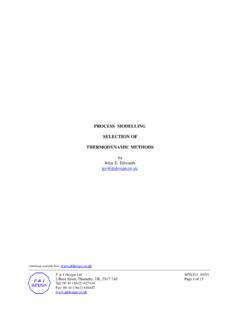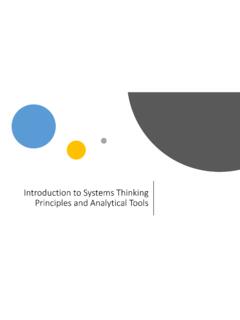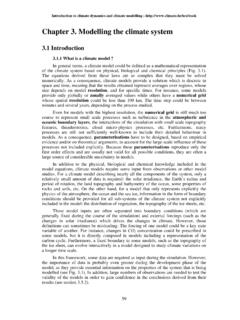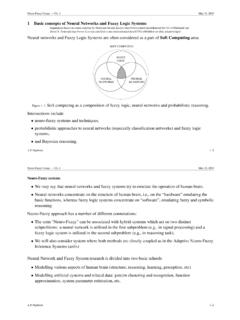Transcription of An Introduction to Mathematical Modelling
1 An Introduction toMathematical ModellingMichael Introductionto MathematicalModellingbyMichael D AlderAn Introduction to Mathematical Edition Michael D Alder, 2001 Warning: This edition is not to beCopied, transmitted, excerpted or printedExcept as authorised by the publisherMathematical Modelling1 IntroductionThis book is based on a course given to first year students doing Calculusin the University o fWestern Australia s Department o fMathematics andStatistics. The unit was for students mainly from the Life Sciences, withsome Economists, Social Scientists, Computer Science students and others,and the aim was to give them some understanding o fthe uses o fCalculusin their areas o fwork.
2 The book was about hal fo fthe complete course, therest being statistical I write in this book from now on is addressed to the reader on theassumption that he or she has a similar background, and similar or broaderinterests. I assume, in other words, that you are not a mathematician, physi-cist or engineer or that i fyou are you have an uncommon and admirablebreadth o finterest in the rest o fthe amount o fMathematics in the so ft sciences has been increasing dra-matically in the last few decades. You might be puzzled as to why this mathematicians somehow able to coerce other departments into push-ing their own merchandise down everybody s throats?
3 No, actually we arevery bad at this. But what is happening is that many areas that used to bedone in a literary sort o fway, with people arguing in natural language, havesuddenly become amenable tomodelling. The main reason is that computershave come into our lives. This means we can explore much more complexsystems than could have been dreamed o ftwenty years ago. The impact onthe research level has been dramatic over the last twenty years, and this isslowly filtering down to the undergraduate are other reasons, more fundamental than the computer revolutionwhy this happens: sciences evolve.
4 They start off as collecting butterflies andnewts and flowers and in a century they are cloning sheep. The evolutionneeds an increase in the precision with which you communicate the facts youhave discovered, and Mathematics is the language o fchoice here. The rise o fthe Physical Sciences and the Engineering that rests upon it has benefitedfrom, and contributed to, the Mathematics that we now have. And practicalpeople wouldn t buy the stuff i fit didn t work. Well, exactly the same factorsmake Mathematics useful to other people D. ALDERS cience works by building models.
5 Not little cardboard and plasticine mod-els, but models made out o fsymbols. We can play with the symbolic modelsand adjust them until they start to behave in a way which resembles thethings we care about. When we have done this, we get an understanding ofthe things we care about which is much deeper than we could ever get i fwestuck to words and pictures. Mathematical models do not replace words andpictures, they sharpen models deepen our understanding o f systems , whether we are talkingabout a mechanism, a robot, a chemical plant, an economy, a virus, anecology, a cancer or a brain.
6 And it is necessary to understand somethingabout how models are made. This book will try to teach you how to buildmathematical models and how to use is a huge range of useful models invading the Life Sciences: RichardDawkins [1, 2, 3] little stick creatures which evolve and mutate can sharpenour ideas, and also dramatise them so you canseeevolution working. Cellularautomata can tell us things about growth and evolution that again sharpenour ideas. The Social Sciences increasingly use models for both numericalpredictions and for qualitative behavioural is largely about systems which change in time and the problem ofsaying something about how this can happen.
7 Since many biological andsocial systems do evolve, there are plenty o fapplications o fCalculus, andsome o fthem are very illuminating. So in this book I shall restrict mysel ftoCalculus; more specifically to what can be done with Ordinary Differentialand Difference Equations. There are lots o ftypes o fmodels we could lookat, but it is a good idea to start off with a type o fmodel which has shownitsel fto be very use ful over a colossal range o am a friendly, chatty sort of bloke, and this is a friendly, chatty book. Ihave tried to make it as readable as possible, but it would be a good idea toread bits o fother text books as is a lot easier i fyou can see why things are done the way theyare, rather than just learning the stuff off by rote.
8 It is also a lot more fun thisway. Most text books assume you already see why, but experience suggeststhat this is in fact where the problem lies. Which is why I am discursive Modelling3friendly. Best of luck! D. , Real Numbers and Guns .. HowtoDoItYoursel Bacteria,People,Money .. DeathandTaxes .. History: Truth, Lies and Radioactivity .. 9356 MICHAEL D. ALDER3 A Menagerie of Difference SomeDefinitions .. Linear(andAffine)DifferenceEquations .. FirstOrderDifferenceEquations .. SecondOrderDifferenceEquations.
9 1144 Iterates of maps: More about Stability .. Higher Dimensional But Killing them in War is OK .. Ordinary Differential First and Second Order linear and affine Equations .. First Order Linear and Affine Equations .. Second Order Linear and Affine Autonomous Equations SystemsofFirstOrderODEs .. SomeApplications .. Zeros o fVector Fields: Stability .. 1847 Serious WhyModelsMatter .. HowToModel .. OneLastModel:DaysofEmpire .. D. 1 FundamentalsI am going to start off by talking about some basic ideas in a chatty sort ofway.
10 It is tempting to take for granted that you already know things thatyou might not. I am going to fight this temptation and am going to give youa sort o fscientist s perspective on the world. It is certainly different fromthe Joe Sixpack or Homer Simpson view o fthe world, and it may be differentfrom yours. So lean back and relax and enjoy the Systems and StatesOne o fthe words which scientists and engineers throw around a lot withoutever actually defining it is the term system . I don t know how to define iteither, but then I couldn t define an elephant, but I can recognise one whenI see it.

